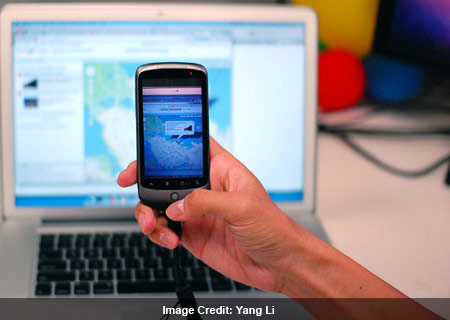
Though most handsets can be hooked up to computers for charging or executing any other function, a technology to bridge the gap wirelessly could be the icing on the cake. Tsung-Hsian Chang, a graduate student in MIT’s Computer Science and Artificial Intelligence Laboratory, and Google’s Yang Li have developed a system known as Deep Shot that will allow users to port apps between a computer and a smartphone by just pointing the device’s camera on the computer screen. This works the other way round too.
The system takes advantage of the fact that most web apps follow a standard format known as uniform resource identifier (URI) to present their status. This functionality seeks the installation of minimal software on the phone and the computer that will interact with the handset. While uploading content on the phone, the system makes use of existing computer vision algorithms to spot and recognize the app on the display.
It then transits the respective URI and the app opens up on the device. If the frame of the photograph is changed, then it will in turn, change the framing of the app window that has been opened on the phone.
“People are used to using heavy tools to transfer data or synchronize two devices. You have to plug in a USB cable and maybe open iTunes and synchronize a bunch of data at the same time. But sometimes you just want to send a tiny bit of information, or a single piece of information,” commented Tsung-Hsian Chang.
At present the system works with common web apps like Google Maps and Yelp. With some minimal code addition it would also run any app that presents its state through URIs. The system can even be used to mediate between different apps as the URIs comprise of a standard set of codes. This will involve porting one Map app from a computer to another one on a phone too. Additionally, if certain codes are modified then this mechanism may also work with off-the-shelf software.
Jeffrey Nichols, a researcher at IBM’s Almaden research center who specializes in mobile devices mentioned, “I find it a really compelling use case, so I would really hope that companies like Microsoft would really consider adding it. I see it being much more likely to happen with websites than with desktop applications. On the other hand, to some extent, we’re moving away from desktop applications and moving more and more to the Web, so it’s not clear to me how important it is that we really bring all the native application developers into the fold.”
Nichols added that actual implementation of the system may depend on broad agreement of interoperability standards which looks pretty difficult. In cases where web developers keep the status of their apps hidden, even people not involved in creating websites can make certain additions to them.
Google owns the rights for the Deep Shot system since Chang was a former intern there. The system has not been released publicly as of now.
